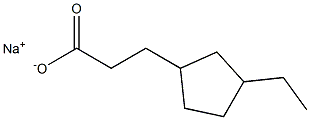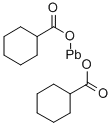Cobalt naphthenate
- CAS NO.:61789-51-3
- Empirical Formula: C22H16CoO4
- Molecular Weight: 403.29324
- MDL number: MFCD25292994
- EINECS: 263-064-0
- SAFETY DATA SHEET (SDS)
- Update Date: 2025-01-27 09:38:02

What is Cobalt naphthenate ?
Description
Cobalt naphthenate is a brown powder or bluish-red solid; Freezing/Melting point =140℃; Flashpoint =49℃; Autoignition temperature =276℃. HazardIdentification (based on NFPA-704 M Rating System):Health 1, Flammability 2, Reactivity 0. Insoluble in water.
Chemical properties
Black liquid
Chemical properties
Cobalt naphthenate is a flammable brown powder or bluish-red solid; freezing/melting point = 140°C; flash point = 49°C; autoignition temperature = 276°C. Hazard identification (based on NFPA-704 M Rating System): Health 1, flammability 2, reactivity 0. Insoluble in water.
The Uses of Cobalt naphthenate
Cobalt naphthenate is widely used in polyester resins and paint driers. It is used as a curing accelerator, cross linker catalyst for unsaturated polyester resins. It is also used in the production of adhesives, varnishes and waterproofing agents for textiles. Further, it is used as corrosion inhibitors, lubricants, and fuel additives. It plays an important role as oil drying agents.
The Uses of Cobalt naphthenate
Cobalt naphthenate may be used as a catalyst that facilitates the free radical polymerization of (3-methacryloxypropyl)trimethoxysilane (MPS), which can be used to functionalize alumina nanoparticles. It can be used as a promoter for the development of unsaturated flame retardant polyesters.
General Description
Cobalt naphthenate is a brown powder or a bluish-red solid. Cobalt naphthenate is easily ignited and once ignited can burn profusely. Cobalt naphthenate is used to make paints and varnish.
Air & Water Reactions
Highly flammable.
Reactivity Profile
COBALT NAPHTHENATE has weak oxidizing or reducing powers. Redox reactions can however still occur. The majority of compounds in this class are slightly soluble or insoluble in water. If soluble in water, then the solutions are usually neither strongly acidic nor strongly basic. These compounds are not water-reactive.
Health Hazard
Fire may produce irritating and/or toxic gases. Contact may cause burns to skin and eyes. Contact with molten substance may cause severe burns to skin and eyes. Runoff from fire control may cause pollution.
Fire Hazard
Flammable/combustible material. May be ignited by friction, heat, sparks or flames. Some may burn rapidly with flare burning effect. Powders, dusts, shavings, borings, turnings or cuttings may explode or burn with explosive violence. Substance may be transported in a molten form at a temperature that may be above its flash point. May re-ignite after fire is extinguished.
Flammability and Explosibility
Not classified
Contact allergens
Cobalt naphthenate is made by treating cobalt hydroxide or acetate with naphthenic acid. It is an accelerant in rubber, unsaturated polyester, and vinyl ester resins.
Safety Profile
Moderately toxic by ingestion. Flammable when exposed to heat or flame. When heated to decomposition it emits acrid smoke and irritating fumes.
Potential Exposure
Cobalt naphthenate is used as a drying agent in paints, varnishes; inks, and for curing plastics.
First aid
If this chemical gets into the eyes, remove anycontact lenses at once and irrigate immediately for at least15 min, occasionally lifting upper and lower lids. Seek medical attention immediately. If this chemical contacts theskin, remove contaminated clothing and wash immediatelywith soap and water. Seek medical attention immediately. Ifthis chemical has been inhaled, remove from exposure,begin rescue breathing (using universal precautions, including resuscitation mask) if breathing has stopped and CPR ifheart action has stopped. Transfer promptly to a medicalfacility. When this chemical has been swallowed, get medical attention. Give large quantities of water and inducevomiting. Do not make an unconscious person vomit.Medical observation is recommended for 24-48 hours afterbreathing overexposure, as pulmonary edema may bedelayed. As first aid for pulmonary edema, a doctor orauthorized paramedic may consider administering a corticosteroid spray
Storage
Color Code—Red: Flammability Hazard: Store ina flammable materials storage area. Prior to working withthis chemical you should be trained on its proper handlingand storage. Store in tightly closed containers in a cool,well-ventilated area away from strong oxidizers (such aschlorine, bromine, and fluorine). Sources of ignition, suchas smoking and open flames, are prohibited where cobaltnaphthenate is used, handled, or stored in a manner thatcould create a potential fire or explosion hazard
Shipping
UN2001 Cobalt naphthenate powder, Hazard Class: 4.1; Labels: 4.1-Flammable solid. UN1993 Flammable liquids, n.o.s., Hazard Class: 3; Labels: 3-Flammable liquid, Technical Name Required
Incompatibilities
Highly flammable; powder or dust can form an explosive mixture with air. Incompatible with oxidizers (chlorates, nitrates, peroxides, permanganates, perchlorates, chlorine, bromine, fluorine, etc.); contact may cause fires or explosions. Keep away from alkaline materials, strong bases, strong acids, oxoacids, epoxides.
Properties of Cobalt naphthenate
| Melting point: | <-7℃ |
| Density | 0.921 g/mL at 25 °C |
| vapor pressure | 0Pa at 20℃ |
| refractive index | n |
| Flash point: | 120 °F |
| storage temp. | 2-8°C |
| form | liquid |
| color | dark |
| Specific Gravity | 0.95 |
| Water Solubility | Insoluble in water. |
| EPA Substance Registry System | Cobalt naphthenate (61789-51-3) |
Safety information for Cobalt naphthenate
| Signal word | Danger |
| Pictogram(s) |
 Flame Flammables GHS02  Exclamation Mark Irritant GHS07  Health Hazard GHS08 |
| GHS Hazard Statements |
H226:Flammable liquids H304:Aspiration hazard H317:Sensitisation, Skin H372:Specific target organ toxicity, repeated exposure H412:Hazardous to the aquatic environment, long-term hazard |
| Precautionary Statement Codes |
P210:Keep away from heat/sparks/open flames/hot surfaces. — No smoking. P273:Avoid release to the environment. P280:Wear protective gloves/protective clothing/eye protection/face protection. P331:Do NOT induce vomiting. P301+P310:IF SWALLOWED: Immediately call a POISON CENTER or doctor/physician. P303+P361+P353:IF ON SKIN (or hair): Remove/Take off Immediately all contaminated clothing. Rinse SKIN with water/shower. |
Computed Descriptors for Cobalt naphthenate
New Products
4,4-Difluoropiperidine hydrochloride tert-butyl 9-methoxy-3-azaspiro[5.5]undecane-3-carboxylate Indole Methyl Resin N-Isopropylurea N,N-Dicyclohexylcarbodiimide(DCC) MELDRUMS ACID 5-METHYLISOXAZOLE-4-CARBOXYLIC ACID Magnessium Bis glycinate Zinc ascorbate 1-bromo-2-butyne 2-acetamidophenol 9(10H)-anthracenone Erythrosin B, 4-Piperidinopiperidine 2-((4-morpholinophenylamino) (methylthio) methylene) malononitrile 2,4-dihydroxybenzaldehyde 3-(4-morpholinophenylamino)-5-amino-1H-pyrazole-4-carbonitrile Methyl 2-methylquinoline-6-carboxylate 2,6-dichloro-4-nitropyridine 4-Bromo-2-chlorobenzonitrile 2-(benzylamino)acetic acid hydrochloride 4-(tert-Butoxycarbonylamino)but- 2-ynoic acid 3,4-dihydro-2H-benzo[b][1,4]dioxepine 1-Phenyl-1-cycloprppanecarboxylicacidRelated products of tetrahydrofuran








You may like
-
 61789-51-3 Cobalt(II) naphthenate 98%View Details
61789-51-3 Cobalt(II) naphthenate 98%View Details
61789-51-3 -
 Cobalt naphthenate CAS 61789-51-3View Details
Cobalt naphthenate CAS 61789-51-3View Details
61789-51-3 -
 Cobalt naphthenate CAS 61789-51-3View Details
Cobalt naphthenate CAS 61789-51-3View Details
61789-51-3 -
 Cobalt Naphthenate (Co ca. 8%) CAS 61789-51-3View Details
Cobalt Naphthenate (Co ca. 8%) CAS 61789-51-3View Details
61789-51-3 -
 Cobalt naphthenate, 6% CAS 61789-51-3View Details
Cobalt naphthenate, 6% CAS 61789-51-3View Details
61789-51-3 -
 Cobalt naphthenate, 8% CAS 61789-51-3View Details
Cobalt naphthenate, 8% CAS 61789-51-3View Details
61789-51-3 -
 Cobalt naphthenate CAS 61789-51-3View Details
Cobalt naphthenate CAS 61789-51-3View Details
61789-51-3 -
 20677-73-0 (2,2-diethoxyethyl)methylamine 98%View Details
20677-73-0 (2,2-diethoxyethyl)methylamine 98%View Details
20677-73-0
